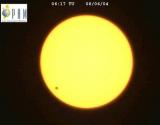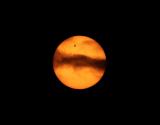Frequently Asked Questions
- What is a transit?
- What can one see during a transit?
- How can we observe a Transit?
- How frequent are Venus transits?
- What about Mercury?
- When did the last transit take placet?
- When will the next transits take place?
- What is the duration of the 5-6th of June transit?
- How is Venus like?
- Who was the first to observe a transit?
- What is the scientific importance of the transit?
- What is the “black drop” effect?
What is a transit?
A Transit is the crossing of a planet or any celestial object in front of the Sun. Mercury and Venus are the only Solar System planets that can give transits, because they are closer to the Sun than the Earth. The Moon can also give transits, and in this case the phenomena is called a Solar eclipse.
What can one see during a transit?
During a transit one sees the disc of the planet projected on the bright surface of the Sun. The planet will appear like a small black disk (due to the contrast between the dark hemisphere of the planet and the bright surface of the Sun) that moves across the Sun. The apparent size of Venus seen from Earth is about 30 times smaller than the size of the sun. Mercury shows an apparent disk about 160 times smaller than the sun.
How can we observe a Transit?
NEVER LOOK DIRECTLY TO THE SUN. Direct Sun observation without appropriate protection o through glasses (including sunglasses), telescopes or any other instrument not designed for this purpose can produce severe eye injuries.
Unlike the transit of Mercury, the apparent diameter of Venus during the transit can be perceived by the naked eye, ALWAYS TAKING THE ABOVE MENTIONED CAUTIONS. In any case, the safest way of observing the transit is projecting the iamge of the Sun in a screen using a telescope (see figure). This observing strategy also allows several people observing the transit at the same time.
|
|
How frequent are Venus transits?
If the orbit of Venus was not inclined with respect to the orbit of the Earth, Venus would transit in front of the Sun once each 584 days (about 19.5 months, the time it takes to repeat the same relative Sun-Venus position as seen from the Earth, that is, the synodic period). However, due to the relative inclination of the orbits (about 3.4 degrees) in most cases Venus crosses above or below the solar disc, without producing a transit. All together causes that the Venus transits take place periodically separated by the following time intervals: 8 years, 121.5 years, 8 years, 105.5 years. In some occasions, like in the 1388 transit, one of the transits of a pair may not occur. Presently the transits can only occur in the months of June and December, grouped by pairs (the two transits of the XXI century will occur in June, while the two transits of the XIX century took place in December, as will occur for the ones of the XXII century).
What about Mercury?
Like in the case of Venus, the orbit of Mercury is inclined with respect to the orbit of the Earth (7 degrees in this case). If this inclination was zero transits would occur every 116 days (its synodic period), but given the actual inclination there are only 13 transits per century, separated by intervals ranging from 3.5 to 13 years. Presently they can only occur in the months of May and November.
When did the last transit take placet?
The last Venus transit took place the 5-6th June of 2012 and almost was not visible from the peninsula, the previous traffic this couple was on the 8th of June 2004. The Transit was entirely visible from all over the peinsula.
From 2004 to the nineteenth century, December 1882. In that occasion the better observation conditions were found in South America. From Spain only the start of the transit was visible, with the Sun low in the horizon. The previous transit had taken place the 9th of December 1974 and the best location for observation was Australia. It was not visible at all from Spain.
The last transit of Venus completely visible from Spain took place the 23rd of May 1283. Obviously, any observer in the Iberian Peninsula followed the transit at that time (in fact, the first observed transit of Venus was the one in 1639, as discussed below).
When will the next transits take place?
The next Venus transit will take place the 11th of June of 2117 and the 2125. Only this last one will be partially visible from Spain, with the Sun low over the horizon. The next transit of Venus observable from Spain in conditions as good as the ones of the 8th of June of 2004 transit will occur the 11th June 2247, but the duration of the transit will be shorter (5h45m instead of 6h4013m).
On the other hand, the next transit of Mercury will take place the 11th November 2019 (visible in Spain from midday onwards).
What is the duration of the 5-6th of June transit?
The expectation for the duration of the 5-6th June 2012 transit is 6 hours and 40 minuts. It should start at 22:09:29 (UT) (for a geocentric observator) and should end at 04:49:27 (UT). The 8th of June 2004 transit had an approximate duration of 6 hours and 13 minutes. It started at 5h13m25s UT (UT = Universal Time, the mean solar time at the Greenwich meridian. To obtain the local time in Spain, 2 hours have to be added when summer daylight saving time is applied and one hour in winter time), with the Sun located at a height of 8 deg (as seen from Barcelona), and ended at 11h26m3s TU, with the Sun at a height of 71 deg (as seen from Barcelona). In the most favorable cases the duration of a transit can be slightly above 8 hours.
The maximum duration of a Mercury transit is of almost 8 hours.
How is Venus like?
Venus is the planet in the Solar System with the most similar size to Earth: it has an equatorial diameter of 12103 km, as compared to the 12756 km of the Earth. Its mass and density are also very similar: Venus has a mass equivalent to 81.5% of the Earth mass, and a density of 5.25 g/cm3, compared to a density of 5.52 g/ cm3 for the Earth. Venus makes a full orbit around the Sun in 224.7 days, with a mean distance of 108 million km (compared respectively to 365 days and 150 million km for the Earth). The similarities to the Earth, however, end here. The rotation period of Venus is 243 days (retrograde), much longer than the Earth (23h56m). Its atmosphere is also very different than the Earth atmosphere, with the carbon dioxide (CO2) being the most abundant element and causing a very strong greenhouse effect that makes the surface temperature to be about 500ºC at a pressure of about 80 atmospheres.
Venus has been visited by many space probes. The probe that has provided the most interesting data was the Magellan spacecraft, launched in 1989 by the NASA. This probe carried out a radio mapping of most of the planet surface.
(From Astronomía General Teórica y Práctica. D.Galadí-Enríquez y J. Gutiérrez Cabello)
|
Mass 0.815Earth masses Equatorial radius 6051.4 km Mean density 5.25 g/cm3 Rotation period 243 days Orbital period 224.701 days Mean distance to the Sun 0.7233 UA (108 million km) Orbital excentricity 0.0068 Orbital inclination 3.4 deg
|
 |
Who was the first to observe a transit?
The first observation of a Venus transit was done in 1639 by the English astronomer J. Horrocks. Kepler had predicted that another transit should take place 8 years before, in 1631, but in spite of all the efforts of the astronomer Gassendi it was not observed because it was not visible from France, a fact not know by him due to the limited precision of Kepler tables. Kepler, however, had not predicted a transit for 1639. It was Horrocks who in October 1639 discovered that the more ancient and less precise (compared with Kepler ones) tables of Lansberg predicted a possible transit in November of that year. Horrocks verified the calculations himself and confirmed this transit. However, given the short time remaining before the transit, the news could not be properly spread and only Horrocks, his brother Jonas and his friend Crabtree were forewarned. Both Horrocks and Crabtree observed the transit and made some measurements, while apparently Horrocks brother was not able to observe it.
The first observation of a Mercury transit was carried on in 1631 by the French astronomer Pierre Gassendi. Even tought that the telescope, needed to observe the transits, was in use since approximately 1610, none observed the 1615, 1618 and 1628 transits, because nobody was aware of its existence. The publication of new tables with the position of the planets (the Rudolphine Tables by J. Kepler) in 1627 allowed the prediction of the 1631 transit and its observation.
What is the scientific importance of the transit?
Nowadays the Venus transits are essentially just a scientific curiosity. The same holds for Mercury transits.
Among the few scientific contributions that the transits can still make today we can highlight the study of the Earth rotation speed. Given the transit circumstances (contact time and site of observation) of a past transit, one can measure small variations on the length of the day along the centuries.
The situation, however, was very different before the XX century. Until that century the Venus transits were used, following the Edmond Halley proposal in 1716, to measure the Astronomical Unit, that is to say, the Earth-Sun distance. Many scientific expeditions were organised to observe the transits of 1761, 1769, 1874 and 1882. However, in spite of the efforts, several observational limitations (specially the black drop effect) prevented an accurate determination of the Astronomical Unit from the Venus transits. During the second half of the XIX century and all along the XX century new methods were devised to measure the Earth-Sun distance, not involving the observation of Venus or Mercury transits, and so these phenomena lost its scientific relevance.
Now, only some phenomena related to the transits (like the above mentioned black drop effect) are still object of study.
What is the “black drop” effect?
Just after the internal contact between the Sun and planet (Venus or Mercury) disks something strange happens. Instead of clearly detaching from the solar limb, the planet’s disc seems to “stick” for some seconds to the border of the solar disc and looses its shape, adopting the appearance of a black drop. This phenomena happens again just before the last internal contact.
 . . |
The black drop effect prevents a precise measurement of the contact times between the solar and planet disks, and was the main cause of the failure in the attempts of precisely measuring the Earth-Sun distance using the Halley method. The main cause of this phenomena is the turbulence in the Earth’s atmosphere, although the fact that the solar disc is slightly darker at its borders than in the centre (limb darkening) also plays an important role.
We can simulate this effect by slowly joining our fingers and observing its shadow. Just before they touch a shadow appears joining them in the shape of a meniscus, in a similar way of what happens between the Sun and planet limbs.
 |
 |
 |
If you want a more complete description of the black drop effect visit
http://nicmosis.as.arizona.edu:8000/POSTERS/TOM1999.jpg![]() (quite technical).
(quite technical).




